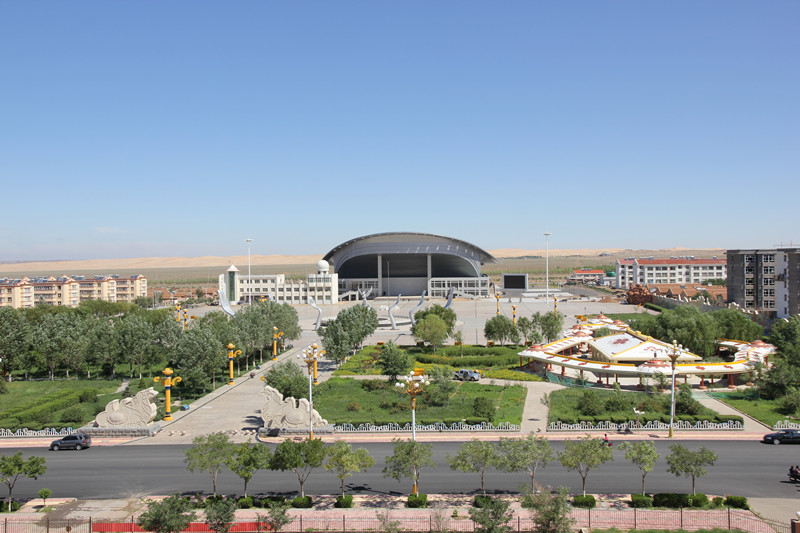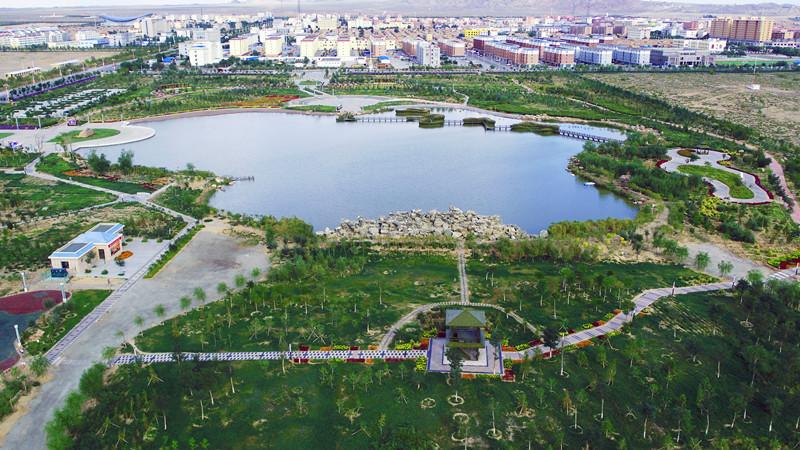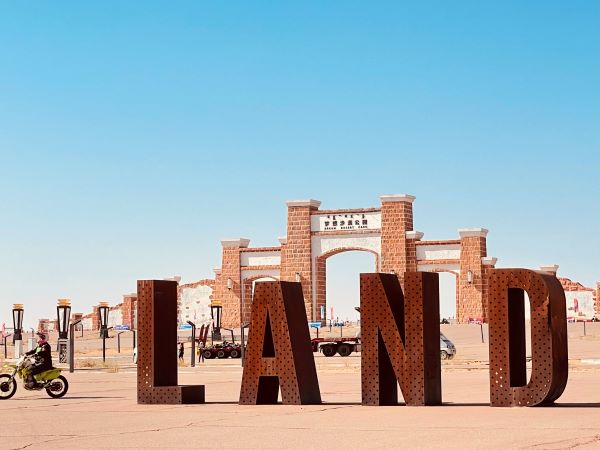Alshaa Right Banner: On track toward economic construction, urbanization
- Updated: 2024-03-01
Alshaa Right Banner is located in the middle of Alshaa League and covers a total area of 73,000 square kilometers. It borders Alshaa Left Banner and Minqin county in Wuwei city, and Gansu province to the east, Jinchang, Shandan, Zhangye, Gaotai and Linze cities and counties in Gansu province to the south, Ejina Banner to the west and Mongolia to the north.
The whole Banner now has jurisdiction over seven Sumu towns, with a total population of 25,000.
Located in the inland plateau, the area has a typical dry continental climate feature. The average annual temperature is 9.2 ℃. The light, heat and wind energy resources are abundant with broad development prospects, but the water resource is poor. There are no perennial rivers, the surface water is scarce, and there is a small amount of spring water in mountainous areas.

Badain Jaran Square in Alshaa Right Banner [Photo/innermongolia.chinadaily.com.cn/alshaa]
Badain Jaran Desert, the third largest desert in the world and the second largest in China, runs through the whole territory. The desert covers a total area of 49,200 square kilometers and 35,000 square kilometers are distributed in the Banner.
Alshaa Right Banner has a long and interesting humanistic history. As early as the Neolithic Age -- defined in China as between 10,000 to 4,000 years ago -- there were footprints of human activities here. The ancient ancestors were known to engage in hunting and grazing, the villages, figures and animals engraved on the rock paintings of Mandela Mountain, and many cultural relics found in Badain Jaran Desert vividly reflected the long and diverse national development process of this area.
The Right Banner is separated from the original Alshaa Banner, which has the deep cultural foundation of Mongolian Heshuote and Kalka.
On Sept 23, 1949, Alshaa Banner was peacefully liberated, and Alshaa Heshuote Banner People's Government was established. The Banner opened a new chapter in history since that day.
In April 1980, Alshaa League was established, and Alshaa Right Banner has been under the jurisdiction of the League since then.
There are 45 minerals and 145 mineral sites discovered in Alshaa Right Banner. Polymetallic resources such as iron, copper, nickel and vanadium are relatively abundant. There are also strategic resources such as niobium, tantalum, fluorite and uranium, high-quality salt and nitrate resources, coal and oil and gas resources but not as plentiful.
The total area of forestry resources is 14.4109 million mu, of which 8.4991 million mu is included in the compensation area for ecological benefits of national public welfare forests, and the forest coverage rate is 7.6 percent.
The unique tourism resources of Alshaa Right Banner include: Badain Jaran Desert, Mandela Rock Painting, Haisenchulu Strange Rock Forest and Eribugai Valley. Badain Jaran Desert is the most distinctive desert, known as "the most beautiful desert in China," and is the main park of Alshaa Desert National Geopark. In 2008, it won the only qualification to be the World Desert Geopark in China.

Alshaa Desert National Geopark [Photo/innermongolia.chinadaily.com.cn/alshaa]
The territory is rich in wild plants and animals, with 121 kinds of medicinal plants and more than 80 forage plants, five kinds of national first-class protected animals and 15 kinds of second-class protected animals. There are abundant mineral resources, such as coal, salt, nitrate, Iceland spar, gold, crystal stone, etc. Among them, graphite, fluorite, iron, marble, and limestone are rich in reserves, with high mining value. In addition, the area is also rich in Cistanche deserticola, Glycyrrhiza uralensis Fisch, Ephedra sinica, Cynomorium songaricum, Ganoderma lucidum and other precious medicinal resources.
After the Third Plenary Session of the Eleventh Central Committee, Alshaa Right Banner shifted its focus to economic construction, and constantly explored ways to give full play to its advantages and accelerate its development in practice.
In 2020, the GDP of the whole region was 2.04 billion yuan ($318 million), a year-on-year increase of 2.2 percent. The budget revenue of public property was 188 million yuan, investment in fixed assets was 1.459 billion yuan, a year-on-year increase of 1.1 percent. The per capita disposable income of urban and rural permanent residents was 44,900 yuan and 25,401 yuan respectively, up 2.5 percent and 6.3percent year-on-year respectively. The retail sales of social consumer goods reached 523 million yuan, down 17.5 percent year-on-year.
A number of infrastructure projects related to the long-term development of the whole region have been built, and the road network structure has been continuously optimized.
The urbanization process has obviously accelerated, and the cities and towns have taken on a new look, with the population urbanization rate reaching 79.12 percent. Social undertakings such as science and technology, education, culture and health have made all-round progress. It has won the title of "National Science and Technology Progress Banner County" for three consecutive times.


